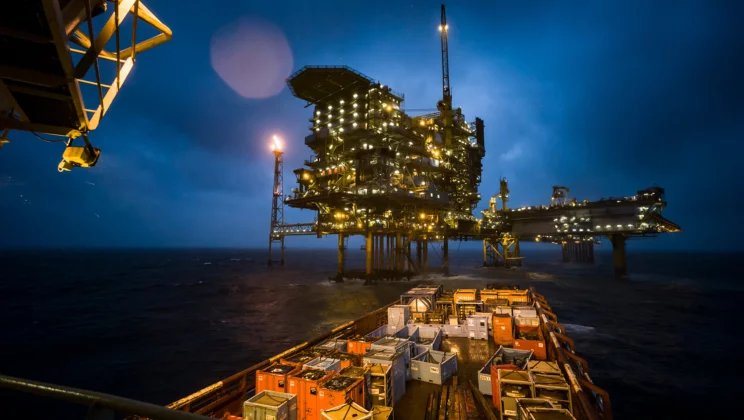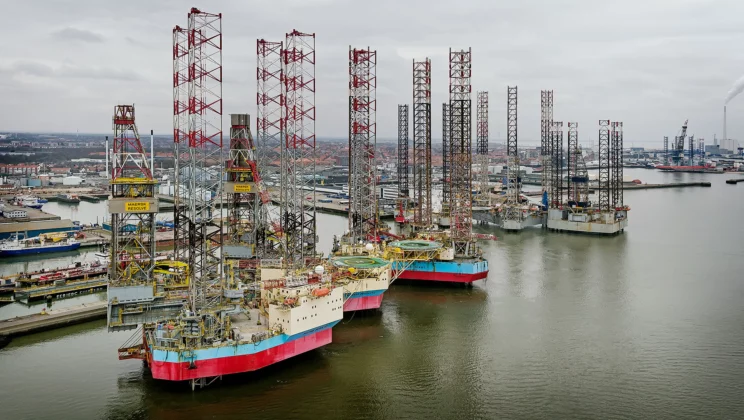After three trying years in the oil and gas industry, the negative trend was reversed in 2017. OPEC’s production cut spells stability in the market in 2018, and experts are forecasting new opportunities in the North Sea on the back of the consolidations in the Danish oil and gas industry. The industry too is confident in growth for 2018.
A buoyant global economy resulted in increased demand in the market in 2017, and by November, the price of a barrel of Brent oil reached its highest level since autumn 2015. In other words, the cautious optimism that characterised the oil market at the start of the year was borne out, explains Jens Nærvig Pedersen, senior analyst with Danske Bank.
“2017 was a good year for the oil and gas industry, due not least to the oil output cuts introduced by OPEC together with Russia. Added to which, a robust global economy has spurred growth on several fronts. When we buy more and travel more, demand for oil goes up,” he says.
The international market research and consultancy firm Westwood Global Energy Group monitored industry trends closely in 2017, with its senior analyst Matt Adams reporting a significant upturn in the industry. One indicator was the number of FPS (Floating Production Systems) projects sanctioned. In 2016, there was a complete dearth of new projects. By 2017, the figure was 17.
”In my view, the upshot of 2017 is that the market is set for a rebound,” says Matt Adams.
That optimism is also all in evidence in the industry. 63 per cent responded that they are confident about growth in 2018. The equivalent figure in 2017 was 32 per cent. This is the finding of DNV-GL Outlook 2018, which surveyed 731 oil and gas industry executives on the outlook for 2018.

”In my view, the upshot of 2017 is that the market is set for a rebound,” says Matt Adams, senior analyst at Westwood Global Energy.
New technology blazes the trail
Another notable finding of the survey is that the industry is reporting new R&D investments for the first time in three years. Two-thirds of the respondents are planning to maintain or increase their R&D expenditure. This is a significant leap relative to 2017, when only 39 per cent answered yes to this question. And more than one third respond that they are planning to increase their R&D investments, which is the highest share in four years.
Matt Adams points out that the conditions for innovation and development are better now than they have been for years. He is also in no doubt that new technology especially is set to drive development in 2018 and beyond.
“We know from onshore projects that we can achieve substantial efficiency gains with the aid of new technology, and we are currently seeing several of the major North Sea operators looking into the options for reducing their production costs. It will be interesting to see just how soon the new technologies impact the offshore sector in 2018,” he says, highlighting three types of technology he will personally be keeping a close eye on.
The first is standardisation in different parts of the value chain, for example, when designing new products to reduce their time to market. The second concerns big data, where new technology is making it possible to process vast volumes of information to identify patterns that can be used for optimising production. Thirdly and finally, Adams highlights the potentials of automation, although these would not be realised until well beyond 2018:
“If the industry ultimately succeeds in implementing automatic drilling rigs and pumps, this will have substantial impact on the expenditure side of output,” he says.
Continued focus on competitiveness
Although 2017 was a good year, and the outlook for 2018 is bright, both Jens Nærvig Pedersen and Matt Adams conclude that the industry should sustain the hard-nosed focus on optimisation and competitiveness that has prevailed in recent years.
“One of the biggest problems in the industry up until 2014 was the outsize scale of the ideas and the new projects. The focus was overly narrow on getting more barrels on the market faster. My hope is that the industry – regardless of upticks – will play safe with cautious investment, e.g. in standardising the value chain in order to bring costs down,” says Matt Adams.
As Jens Nærvig Pedersen sees it, the most likely scenario in 2018 will be for the price to stabilise rather than rise further. Which makes it important to continue to focus on optimising production with efficiency improvements to get the industry into gear – even if 2019 takes a different turn.
“In the Danish share of the industry, we should be calling for efficiency improvements so as to retain our competitiveness. Because the competition is set to increase from operators such as OPEC and the American shale producers,” he says.
Consolidations hold opportunities in the North Sea
2017 was an eventful year in the Danish oil and gas industry. In the spring, British INEO acquired Danish DONG Energy’s oil and gas business, and later in the year came the news of TOTAL’s acquisition of Maersk Oil, which has just been approved by the authorities. Meanwhile, the largest investment ever in the Danish sector of the North Sea went ahead when Danish Underground Consortium (DUC) and Maersk Oil agreed to invest EUR 2.81bn in redevelopment of the Tyra field.
These consolidations in the market bode well for the efforts to maintain the competitiveness of the industry in Denmark to ensure its survival on the global market. Plus, explains Jens Nærvig Pedersen, the timing is good in relation to Tyra:
“Redevelopment of the Tyra field makes far more sense today than it did three years ago because of the current market outlook. Demand globally is rising, so the resources are likely to be in demand for the long term,” he says.
According to Matt Adams, the two major consolidations on the Danish market in 2017 reflect a distinct trend across markets and national borders:
“It’s a question of honing the business. Ørsted, for example, is pursuing a new strategy distanced from oil and gas, whereas INEOS is focused on oil and gas production in the North Sea, so it has a different interest in ramping up development through new investments in older production facilities, for example. In that sense, it bodes well,” he says.
Flemming Horn Nielsen, CEO of INEOS Oil & Gas Denmark, confirms that the acquisition of DONG Energy’s activities was made with development in mind:
“Our ambition is to grow the business to make it a significant operator in the North Sea, with a portfolio of both production and short and long-term development projects,” he says.
By acquiring the DONG Energy assets, INEOS is now positioned as the biggest private enterprise operating in the North Sea. INEOS’ investment in these waters is no coincidence either, explains Flemming Horn Nielsen:
“INEOS’ objective is to expand our oil and gas business, and on that front, the North Sea holds huge potential, which we will be exploring further in 2018. In the first instance, the aim is to operate the existing activities effectively and then to look for new investment opportunities,” is how he explains the prospects in sight, while stressing that the expertise that resided in Dong Energy in relation to the offshore activities was a key factor for INEOS in making the acquisition.

Consolidations in the market bode well for the efforts to maintain the competitiveness of the industry in Denmark to ensure its survival on the global market, explains Jens Nærvig Pedersen.
A necessary transition in the pipeline
The bright prospects for 2018 do not mean maintaining the status quo.
“The key determinant for the scale of oil production generally is basically the number of people on the planet, and as the global population continues to grow, we can undoubtedly expect increased demand. That said, the demand patterns are ultimately set to change, meaning that we will be exporting more to remote markets rather than local ones. Our products are destined for China, India and Africa,” predicts Jens Nærvig Pedersen.
“The energy demand trend will in any case rise so steeply up to 2020 that renewables will not be able to meet demand. This is why oil and gas are still significantly in play”, says Jens Nærvig Pedersen.
“One of the biggest challenges facing the industry will be the same as that pre-crisis in 2014: to attract skilled labour,” says Matt Adams.
“We risk finding ourselves in a situation where the oil and gas industry needs the workforce that was shed in the wake of the 2014 oil price crash. The problem being that this skilled labour is now working in other industries and is not necessarily about to make a return,” he says, stressing that the shortage of engineers is a problem in many of the North Sea states such as the UK and Denmark.
“The industry should work on its brand if it wants to attract the younger generation. That might mean highlighting the strong commitment to innovation and development that is set to shape the industry in 2018,” is his suggestion.
Finally, there are all the unknowns, says Jens Nærvig Pedersen. Basically, the oil and gas market is so dependent on geopolitics and the global economy that it can take a different turn in no time:
“What keeps most analysts awake at night is the fact that we have not had a crisis or recession for a long while – because it’s almost too good to be true,” he says.
That said, looking ahead into 2018, the going still looks good.
“The prospects certainly seem to be shaping up nicely,” says Jens Nærvig Pedersen.
Go to overview

